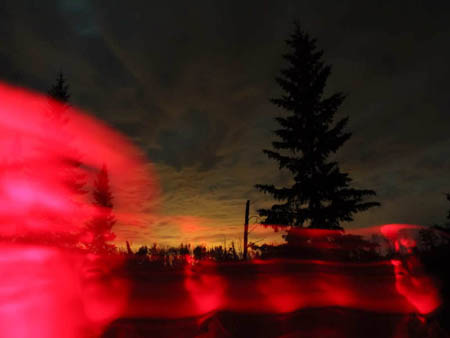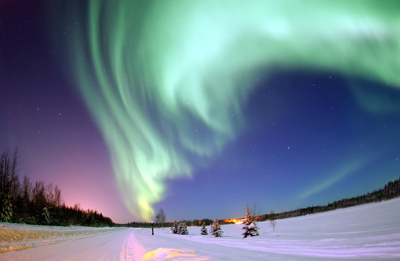Path of NASA's 20-year-old Upper Atmosphere Research Satellite (UARS before it plunged into the Pacific Ocean, with its orbital debris covering a 500-mile stretch in the Pacific. Image courtesy of NASA
With mystery surrounding as to where exactly debris from a six-tonne decommissioned NASA satellite fell early on Saturday – the biggest crash of a NASA satellite since 1979 – NASA remains adamant the satellite’s debris fell in the Pacific Ocean, over an 804-kilometre stretch. The crash comes as planet Earth gears up for more solar storm activity today.
The 5,897kg Upper Atmosphere Research Satellite (UARS) was originally sent into orbit aboard a space shuttle mission (STS-48) on 15 September 1991. Its aim was to study ozone and other chemicals in the Earth’s atmosphere.
“It was the first multi-instrumented satellite to observe numerous chemical components of the atmosphere for better understanding of photochemistry. UARS data marked the beginning of many long-term records for key chemicals in the atmosphere. The satellite also provided key data on the amount of light that comes from the sun at ultraviolet and visible wavelengths,” said NASA.
In 2005, UARS completed its mission. Since then, it had been gradually losing altitude.
“NASA’s decommissioned Upper Atmosphere Research Satellite (UARS) fell back to Earth between 11:23 p.m. EDT Friday, Sept. 23 and 1:09 a.m. Sept. 24, 20 years and nine days after its launch on a 14-year mission that produced some of the first long-term records of chemicals in the atmosphere,” said NASA in a statement on Saturday.
NASA said the precise re-entry time and location of debris impacts have not been determined.
“During the re-entry period, the satellite passed from the east coast of Africa over the Indian Ocean, then the Pacific Ocean, then across northern Canada, then across the northern Atlantic Ocean, to a point over West Africa. The vast majority of the orbital transit was over water, with some flight over northern Canada and West Africa.”
NASA claimed that, six years after the end of its scientific life, UARS broke into pieces during re-entry, with most of it burning up in the atmosphere.
“Data indicates the satellite likely broke apart and landed in the Pacific Ocean far off the U.S. coast. Twenty-six satellite components, weighing a total of about 1,200 pounds, could have survived the fiery re-entry and reach the surface of Earth. However, NASA is not aware of any reports of injury or property damage.”
Via teleconference on Saturday, NASA’s chief scientist for orbital debris, Nick Johnson, informed journalists that the satellite’s trajectory finished after it crossed over parts of the Indian Ocean and Africa.
He said that the 13,000-pound UARS most likely either disintegrated or spread debris over an 804-kilometre Pacific Ocean expanse.
There had been earlier rumours circulating via social media that debris from the satellite had reached part of Calgary in Canada. However, NASA said these reports were unfounded, with data indicating that the 35-foot satellite most likely fell into the Pacific Ocean, away from human civilisation.
“We can now confirm that #UARS is down!” said the official NASA Twitter account on early Saturday morning.
Solar storms activity predicted to affect the planet today: 26 September

On Saturday (24 September), the same day as the satellite crash, Sunspot 1302 unleashed an X1.9-category solar flare at 5.40am, according to NASA’s Solar Dynamics Observatory (SDO). It recorded the extreme ultraviolet flash in composite wavelengths.
Said NASA: “The movie … also shows a shadowy shock wave racing away from the blast site.
“This is a sign that the blast produced a coronal mass ejection (CME) that could deliver a glancing blow to Earth’s magnetic field on Sept. 26.”
NASA said the X1.9-flare, active region (AR) 1302 has “unleashed M8.6 and M7.4 flares on Sept. 24 and an M8.8 flare early on Sept. 25. None of the blasts have been squarely Earth-directed, but this could change as the sunspot turns toward our planet in the days ahead. AR1302 is growing and shows no immediate signs of quieting down.”
We will keep you updated on any updates on this solar flare and any resulting CMEs.
There has been a lot of solar activity in recent months. In early August, Siliconrepublic.com reported that a solar storm was predicted to affect telecommunications globally around that time.
Because the sun is set to reach the maximum of its 11-year cycle next year, this is increasing the frequency of solar flares that spark aurorae displays similar to the aurora borealis one sees in the northern latitudes such as Alaska, northern Scandinavia, parts of Canada, Russia and the Arctic.
NASA describes a solar flare as an explosion on the sun that happens when energy stored in twisted magnetic fields (usually above sunspots) is suddenly released.
Such flares produce a burst of radiation across the electromagnetic spectrum, ranging from radio waves to x-rays and gamma-rays.
Massive bursts of solar wind, known as coronal mass ejections (CMEs), or ‘solar burps’, are associated with solar flares.

The aurora borealis shining above Bear Lake in Alaska
On 5 August 2011, a widespread display of aurorae erupted when a double-CME hit the Earth’s magnetic field and sparked a G4 category geomagnetic storm, according to NASA. As well as in Canada, the Northern Lights could be seen in the US in states such as Utah, Colorado and Nebraska. NASA got reports from people in the UK, Poland and Germany who also witnessed the aurorae.
At the time NASA said Sunsport 1263 was posing a continual threat for x-class solar flares.
Solar superstorm of 1859
The strongest solar storm ever recorded happened on 1-2 September 1859. It caused aurorae to be seen all over the world, while telegraph systems in Europe and North America also failed, with pylons emitting sparks. British astronomer Richard Carrington and Richard Hodgson were the first scientists to independently make observations of a solar flare during the 1859 storm when they viewed a large flare in white light.
ISS over Ireland
This morning the International Space Station (ISS) also crossed Irish skies, coming up Southwest at 05:53 (Dublin region).
For those of us who were fortunate enough to witness the ISS, it flew over at 21 degrees, passing over southwest and heading for the east, lasting two minutes. According to Twisst it looked like a very bright star (magnitude -1.6).
Twisst says the next pass of ISS after this will be 27 September 2011 at 06:28:48 IST.
Middle image (red hue): Lance Taylor took this photograph of the geomagnetic storm that affected the earth on 5 August 2011. He submitted the photo to Spaceweather.com on that night. Taylor took the photo at Cooking Lake Blackfoot area near Edmonton, Alberta, and observed the display from 10pm until 3am. “After the geomagnetic storm we were then treated to a fantastic thunderstorm with a freakish amount of ground strike lightning in it. An amazing and memorable night of observing indeed,” said Taylor at the time